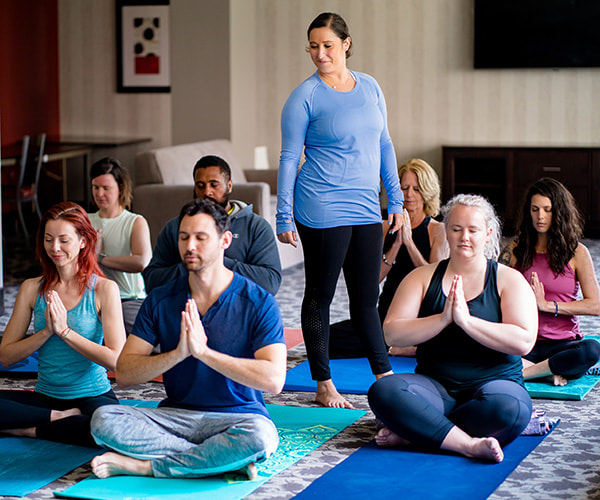Dealing with work-related stress through mindfulness

Introduction
Define work-related stress and its negative impact on mental health and productivity. Explain the benefits of mindfulness in managing stress.
Understanding Work-Related Stress
Discuss common causes of work-related stress (e.g., workload, deadlines, conflicts with coworkers or supervisors). Describe how stress affects mental and physical health.
Practicing Mindfulness
Define mindfulness and its benefits. Explain different mindfulness techniques (e.g., breathing exercises, meditation, body scan) Provide examples of how to incorporate mindfulness into daily routine.
Strategies for Managing Work-Related Stress
Offer practical tips for reducing stress at work (e.g., prioritizing tasks, taking breaks, delegating tasks) Explain how to create healthy boundaries between work and personal life. Discuss the importance of self-care and stress-reducing activities outside of work.
Conclusion
Recap the importance of managing work-related stress for mental health and productivity. Encourage employees to practice mindfulness and prioritize self-care in their daily lives.
Define work-related stress and its negative impact on mental health and productivity. Explain the benefits of mindfulness in managing stress.
Understanding Work-Related Stress
Discuss common causes of work-related stress (e.g., workload, deadlines, conflicts with coworkers or supervisors). Describe how stress affects mental and physical health.
Practicing Mindfulness
Define mindfulness and its benefits. Explain different mindfulness techniques (e.g., breathing exercises, meditation, body scan) Provide examples of how to incorporate mindfulness into daily routine.
Strategies for Managing Work-Related Stress
Offer practical tips for reducing stress at work (e.g., prioritizing tasks, taking breaks, delegating tasks) Explain how to create healthy boundaries between work and personal life. Discuss the importance of self-care and stress-reducing activities outside of work.
Conclusion
Recap the importance of managing work-related stress for mental health and productivity. Encourage employees to practice mindfulness and prioritize self-care in their daily lives.
Building good work relationships with your co-workers

Introduction
Explain the importance of building good work relationships with co-workers
Briefly discuss the benefits of having positive work relationships.
Communication
Discuss the importance of effective communication in building good work relationships. Offer tips for active listening, clear and concise messaging, and addressing conflict constructively. Provide examples of how to communicate effectively in different workplace scenarios (e.g., team meetings, one-on-one conversations, email communication).
Collaboration
Explain the importance of collaborating with co-workers to build good work relationships. Discuss the benefits of sharing knowledge and skills with others in the workplace. Offer strategies for collaborating effectively with co-workers, including setting goals, sharing responsibilities, and providing constructive feedback.
Respect and Empathy
Discuss the importance of treating co-workers with respect and empathy
Offer strategies for building empathy and rapport, such as active listening, expressing appreciation, and avoiding judgment. Provide examples of how to demonstrate respect and empathy in the workplace, including valuing diversity, acknowledging others' perspectives, and honoring commitments.
Conflict Resolution
Explain the importance of conflict resolution in building good work relationships
Offer strategies for resolving conflicts constructively, including listening actively, expressing needs and concerns, and finding mutually beneficial solutions.
Provide examples of how to resolve conflicts in different workplace scenarios (e.g., disagreements over project goals, personality clashes).
Conclusion
Recap the importance of building good work relationships with co-workers
Explain the importance of building good work relationships with co-workers
Briefly discuss the benefits of having positive work relationships.
Communication
Discuss the importance of effective communication in building good work relationships. Offer tips for active listening, clear and concise messaging, and addressing conflict constructively. Provide examples of how to communicate effectively in different workplace scenarios (e.g., team meetings, one-on-one conversations, email communication).
Collaboration
Explain the importance of collaborating with co-workers to build good work relationships. Discuss the benefits of sharing knowledge and skills with others in the workplace. Offer strategies for collaborating effectively with co-workers, including setting goals, sharing responsibilities, and providing constructive feedback.
Respect and Empathy
Discuss the importance of treating co-workers with respect and empathy
Offer strategies for building empathy and rapport, such as active listening, expressing appreciation, and avoiding judgment. Provide examples of how to demonstrate respect and empathy in the workplace, including valuing diversity, acknowledging others' perspectives, and honoring commitments.
Conflict Resolution
Explain the importance of conflict resolution in building good work relationships
Offer strategies for resolving conflicts constructively, including listening actively, expressing needs and concerns, and finding mutually beneficial solutions.
Provide examples of how to resolve conflicts in different workplace scenarios (e.g., disagreements over project goals, personality clashes).
Conclusion
Recap the importance of building good work relationships with co-workers
Mindful Journey: An Hour of Meditation & Relaxation

Introduction (5 minutes)
Welcome and introduction to the class. Explanation of the benefits of meditation.
Brief overview of the session
Preparatory Exercises (10 minutes)
Gentle stretching and warm-up exercises to relax the body. Focused breathing exercises to calm the mind. Setting intentions for the meditation practice.
Mindfulness Meditation (20 minutes)
Guided meditation focusing on the breath. Encouraging participants to observe their thoughts without judgment. Gentle reminders to bring attention back to the present moment. Exploration of bodily sensations and emotions.
Loving-Kindness Meditation (15 minutes)
Explanation of loving-kindness meditation and its purpose. Guided meditation focused on cultivating feelings of compassion and love. Encouragement to extend loving-kindness towards oneself and others. Silent meditation allowing participants to continue the practice independently.
Mindful Movement (5 minutes)
Introduction to mindful movement as an embodiment practice. Gentle movements, such as walking or stretching, performed mindfully. Encouragement to maintain awareness of the body and breath during movement
Closing and Integration (5 minutes)
Gentle transition to a seated position. Reflection on the meditation experience. Guidance on carrying mindfulness into daily life. Gratitude and closing remarks.
Note: The above outline is a general framework for a one-hour meditation class. The durations mentioned for each section can be adjusted based on the specific needs and preferences of the participants. Additionally, you may consider including any specific meditation techniques or themes that align with your teaching style and the goals of the class.
Welcome and introduction to the class. Explanation of the benefits of meditation.
Brief overview of the session
Preparatory Exercises (10 minutes)
Gentle stretching and warm-up exercises to relax the body. Focused breathing exercises to calm the mind. Setting intentions for the meditation practice.
Mindfulness Meditation (20 minutes)
Guided meditation focusing on the breath. Encouraging participants to observe their thoughts without judgment. Gentle reminders to bring attention back to the present moment. Exploration of bodily sensations and emotions.
Loving-Kindness Meditation (15 minutes)
Explanation of loving-kindness meditation and its purpose. Guided meditation focused on cultivating feelings of compassion and love. Encouragement to extend loving-kindness towards oneself and others. Silent meditation allowing participants to continue the practice independently.
Mindful Movement (5 minutes)
Introduction to mindful movement as an embodiment practice. Gentle movements, such as walking or stretching, performed mindfully. Encouragement to maintain awareness of the body and breath during movement
Closing and Integration (5 minutes)
Gentle transition to a seated position. Reflection on the meditation experience. Guidance on carrying mindfulness into daily life. Gratitude and closing remarks.
Note: The above outline is a general framework for a one-hour meditation class. The durations mentioned for each section can be adjusted based on the specific needs and preferences of the participants. Additionally, you may consider including any specific meditation techniques or themes that align with your teaching style and the goals of the class.
Yoga Workplace Series

I. Introduction
A. Greeting and warm welcome to the yoga class
B. Brief explanation of the class format and goals
C. Introduction to any specific theme or focus for the class
II. Warm-up
A. Centering and grounding exercises (e.g., seated meditation, deep breathing)
B. Gentle stretches and joint mobilization exercises to warm up the body
C. Sun salutations or flow sequence to further warm up and energize
III. Asana Practice
A. Series of yoga poses (asanas) focusing on different parts of the body and movement patterns
1. Standing poses (e.g., warrior poses, lunges)
2. Balancing poses (e.g., tree pose, eagle pose)
3. Seated poses (e.g., forward folds, twists)
4. Backbends and heart openers (e.g., cobra pose, bridge pose)
5. Inversions (optional, depending on the level and preferences of the students)
B. Emphasis on proper alignment, breath awareness, and modifications for different levels of practitioners
C. Encouragement to explore variations and find a balance between effort and ease in each pose
IV. Pranayama and Breathwork
A. Introduction to different pranayama techniques (e.g., alternate nostril breathing, ujjayi breath)
B. Guided practice of pranayama exercises to enhance breath awareness and energy flow
C. Integration of breathwork with asana practice to deepen the mind-body connection
V. Cool Down and Relaxation
A. Gentle stretches and restorative poses to release tension and promote relaxation
B. Savasana (corpse pose) for deep relaxation and integration of the practice
C. Guided meditation or visualization to promote inner calm and mental clarity
VI. Closing
A. Expressing gratitude to the students for their participation
B. Optional sharing of insights or experiences from the practice
C. Offer suggestions for incorporating the benefits of yoga into daily life
Note: The outline provided is a general framework for a yoga class. Actual class structure and specific poses may vary depending on the level of students, instructor preferences, and any particular focus or theme chosen for the class.
A. Greeting and warm welcome to the yoga class
B. Brief explanation of the class format and goals
C. Introduction to any specific theme or focus for the class
II. Warm-up
A. Centering and grounding exercises (e.g., seated meditation, deep breathing)
B. Gentle stretches and joint mobilization exercises to warm up the body
C. Sun salutations or flow sequence to further warm up and energize
III. Asana Practice
A. Series of yoga poses (asanas) focusing on different parts of the body and movement patterns
1. Standing poses (e.g., warrior poses, lunges)
2. Balancing poses (e.g., tree pose, eagle pose)
3. Seated poses (e.g., forward folds, twists)
4. Backbends and heart openers (e.g., cobra pose, bridge pose)
5. Inversions (optional, depending on the level and preferences of the students)
B. Emphasis on proper alignment, breath awareness, and modifications for different levels of practitioners
C. Encouragement to explore variations and find a balance between effort and ease in each pose
IV. Pranayama and Breathwork
A. Introduction to different pranayama techniques (e.g., alternate nostril breathing, ujjayi breath)
B. Guided practice of pranayama exercises to enhance breath awareness and energy flow
C. Integration of breathwork with asana practice to deepen the mind-body connection
V. Cool Down and Relaxation
A. Gentle stretches and restorative poses to release tension and promote relaxation
B. Savasana (corpse pose) for deep relaxation and integration of the practice
C. Guided meditation or visualization to promote inner calm and mental clarity
VI. Closing
A. Expressing gratitude to the students for their participation
B. Optional sharing of insights or experiences from the practice
C. Offer suggestions for incorporating the benefits of yoga into daily life
Note: The outline provided is a general framework for a yoga class. Actual class structure and specific poses may vary depending on the level of students, instructor preferences, and any particular focus or theme chosen for the class.

